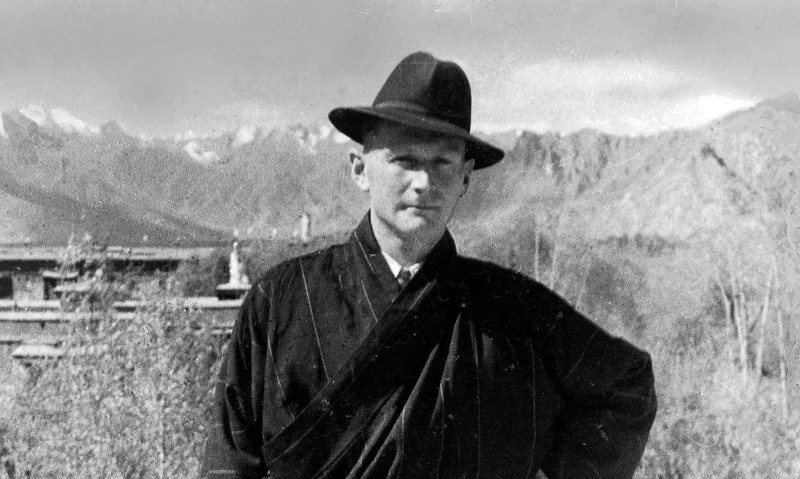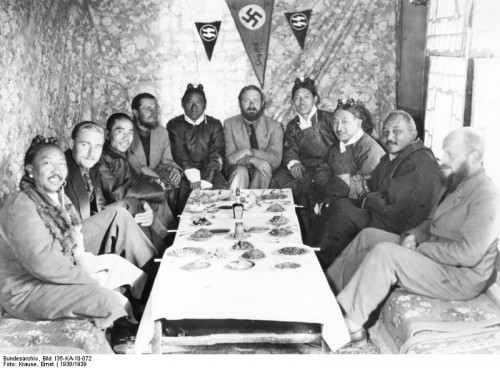(Historic) Nazis & The Search for Yeti
Heinrich Harrer in Tibet
I got to first thinking about Nazis, Tibet, and Yeti, three years ago, when I heard that famed mountaineer Heinrich Harrer, 93, died on January 7, 2005. The entire story does feel like it is straight out of Indiana Jones, of course.
Movies are often a point of reference, needless to say. Harrer was portrayed by Brad Pitt in Seven Years in Tibet, a 1997 movie based on Harrer’s 1953 nonfiction memoir with the same title.
But sometimes the movies leave out the best parts.
Harrer’s interest in what today we mostly know as the lore of the Yeti seems rather minor, but he was, nevertheless, aware of the Abominable Snowman. Could he have known about them more than he wanted to talk about in this 1953 book?
Today it is understood the Nazis were interested in the Yeti during the 1930s, as mentioned in Christopher Gale’s Himmler’s Crusade: The True Story of the 1938 Nazi Expedition to Tibet. Gale discusses the events that lead Reichsführer SS Heinrich Himmler, as director of an organization called Ancestral Heritage, to sponsor a Tibetan Nazi expedition from 1938-1939.
Ernst Schäfer in Tibet
Headed by ornithologist Ernst Schäfer, the 1938 Nazi adventure to Tibet was the third for Schäfer. He had been on two earlier ones to Tibet in the 1930s, lead by explorer Brooke Dolan of the Philadelphia Academy of Natural History.
As noted in an appendix to my book Tom Slick, Dolan was a character in cryptozoology and the shadowy word of international intrigue.
Dolan had been on the second expedition of Teddy Roosevelt’s son, Kermit, to Tibet to kill giant pandas in 1930-1932. Kermit became an important member (i.e. spy) of the Office of Strategic Services (OSS) and later the Central Intelligence Agency (CIA).
For example, in 1942, Dolan, on a espionage mission for the OSS, would take a secret trip to befriend the Dalai Lama in Tibet. A probable contact of Dolan’s along the way was the late “French Chef,” Julia McWilliams Child, an agent for the OSS at the time in China.
Other Nazis in Tibet.
Besides Schäfer, the Nazi’s 1938 expedition also included anthropologist Bruno Beger. Beger is mostly recalled as having gathered and analyzed over three hundred skulls during the trek to prove that Tibet was the birthplace of a “Northern Race” (the Aryans).
Schäfer and Beger were aware of the native reports of the Yeti, or as it was called, the “Migyud,” which is close to the name “Mi-go” found in some cryptozoological sources. Schäfer, however, follows the heavily Austrian-German theory, and felt what they were looking for was a large unknown bear.
Gale wrote: “Green Lake was, according to local legend, the lair of the Migyud, and the camp’s proximity to the legendary creature’s alleged home led to much whispered speculation and anxiety.”
Did Heinrich Harrer know what the Nazis were up to in 1938, when Harrer was becoming the first person to climb the north face of Switzerland’s famous Eiger mountain in 1938. [In the 1990s, Harrer admitted he was a member of the National Socialist German Workers Party (Nationalsozialistische Deutsche Arbeiterpartei), the Nazis, specifically being in Himmler's SS, the special secret police unit of Hitler's Germany.]
As it will be recalled, Harrer escaped, as a Nazi prisoner of the British in India, to Tibet in 1944 and then stayed there for the next seven years.
In Seven Years in Tibet, Harrer, while in Tibet, once found footprints in the snow, which he said that “people with more imagination” than him might associate with the “Abominable Snowman.”
Harrer is also curiously mentioned as once having some interest in the Dremo of Tibet. The Dremo (or Dre-Mon in Odette Tchernine’s books) is a probable cryptid bear, often confused with the more traditional Yeti and Met-teh, unknown hairy hominoids seen in the valleys of the Himalaya.
(For more on Nazi-involved theories, see what I’ve written about the “Apes in Green Hell.”)


